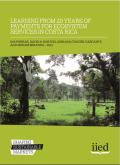This case study calculates a hazard index for every square kilometer of the United States coastline using five sea-level-rise scenarios. This index is then used to identify the most vulnerable people and property as indicated by being in the upper quartile of hazard for the nation’s coastline. The study delivers the first national map of risk reduction owing to natural habitats and thus indicates where conservation and restoration of reefs and vegetation have the greatest potential to protect coastal communities.
This summary reports on a pilot Payment for Ecosystem Services (PES) project funded by South West Water in the catchment of the River Fowey in Cornwall. The scheme looks to fund capital investments on farms that will serve to improve water quality in the River Fowey. This report follows and documents the process of designing and implementing the PES scheme as well as providing an evaluation of the successes and failures of that process in order to provide insights into issues that might arise in similar projects across the United Kingdom.

This case study discusses the history, contributions, and hurdles faced by Costa Rica’s payment for ecosystem services (PES) programme, which was one of the first nationalized programmes of its kind. It also provides clear and concise recommendations of how the programme could be improved to balance conservation goals, development goals, and the provision of ecosystem services.

This resource is also available in English.
This case study discusses the history, contributions, and hurdles faced by Costa Rica’s payment for ecosystem services (PES) programme, which was one of the first nationalized programmes of its kind. It also provides clear and concise recommendations of how the programme could...
This study introduces an approach for assessing the combined risk to marine habitats from multiple human activities, and applies it to coral reefs, mangrove forests, and seagrass beds in Belize to inform the design of the country’s first Integrated Coastal Zone Management (ICZM) Plan.
This study assesses changes in 15 different ecosystem services from 26 different soil management measures (e.g. mulching, terracing, no-till) across 16 case study sites in Europe. Overall, the results are positive in terms of the impacts of the measures on ecosystem services, with 18 out of 26 measures having no decrease in any ecosystem service at the plot level.
The Shandong Energy Efficiency and Emission Reduction Project supported by the Asian Development Bank (ADB) highlighted the impact of supporting the industry sector to invest in technology innovations that lead to reduced energy costs and enhanced market competitiveness.
This study looks at various avenues for renewable energy to access capital markets.
This report was produced in the context of the Knowledge Innovation Project on an Integrated system of Natural Capital and ecosystem services Accounting (KIP INCA), which aims to develop a set of experimental accounts at the EU level, following the System of Environmental-Economic Accounting - Experimental Ecosystem Accounting (SEEA-EEA). It assesses and accounts for two ecosystem services: outdoor recreation (on a daily basis) and crop pollination. Each service is assessed biophysically using the ESTIMAP toolbox, and then translated into monetary units using valuation methods consistent with the System of National Accounts.
This study investigates the economic viability of the Republic of Korea’s national forestation programme, which began in the 1960s and ultimately resulted in the successfully recovery of its forests and the ecosystem services associated with them. The study found that the programme was economically viable in the long-term, with the break-even point of the extensive investment on forestation appearing within two decades. In addition, this study highlights some key lessons from Korea’s programme that other countries could apply to maximize the probability of success in their own countries.
